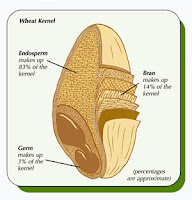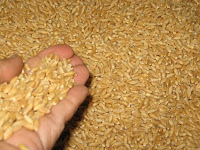Agriculture | Wheat | Wheat is a grass, originally from the Fertile Crescent region of the Near East, but now cultivated worldwide. In 2007 world production of wheat was 607 million tons, making it the third most-produced cereal after maize (784 million tons) and rice (651 million tons). Wheat includes any agricultural cereal grass of the genus Triticum in the grass family Poaceae. Wheat is one of the top three cereal crops in terms of global production, along with maize and rice; together wheat, maize, and rice provide over half of the global requirement of calories and protein (Biodiversity International, 2007). Wheat can grow in a wide range of climates; though, it grows most favorably in temperate climates and is susceptible to disease in very hot and humid zones.
Reflecting human creativity, there are over fifty thousand cultivars of wheat currently in existence. Three important species of wheat are Triticum aestivum (common wheat), Triticum durum, and T. compactum; T. aestivum is used to make bread, T. durum is used to make pasta, and T. compactum is used to make softer cakes, crackers, cookies, and pastries.
Wheat provides other values to human beings as well. It is used for fermentation to make biofuel, beer (Palmer, 2001), and vodka (Neill, 2002). Wheat is planted to a limited extent as a forage crop for livestock and the straw can be used as fodder for livestock or as a construction material for roofing thatch (A. Smith, 1995).
Globally, wheat is the leading source of vegetable protein in human food, having a higher protein content than either maize (corn) or rice, the other major cereals. In terms of total production tonnages used for food, it is currently second to rice as the main human food crop, and ahead of maize, after allowing for maize's more extensive use in animal feeds.
Wheat was a key factor enabling the emergence of city-based societies at the start of civilization because it was one of the first crops that could be easily cultivated on a large scale, and had the additional advantage of yielding a harvest that provides long-term storage of food. Wheat is a factor in contributing to city-states in the Fertile Crescent including the Babylonian and Assyrian empires. Wheat grain is a staple food used to make flour for leavened, flat and steamed breads, biscuits, cookies, cakes, breakfast cereal, pasta, noodles, couscous and for fermentation to make beer, other alcoholic beverages, or biofuel.
Wheat is planted to a limited extent as a forage crop for livestock, and its straw can be used as a construction material for roofing thatch. The whole grain can be milled to leave just the endosperm for white flour. The products of this are bran and germ. The whole grain is a concentrated source of vitamins, minerals, and protein, while the refined grain is mostly starch.
Wheat is a member of the grass family, Poaceae, one of the largest and most important plant families, which also includes rice and sugar cane. There are about 600 genera and perhaps ten thousand species of grasses.
Grasses, like orchids and palms, are monocotyledons. Monocotyledons are one of two major groups of flowering plants (angiosperms), the other being dicotyledons. Monocotyledons have only one cotyledon, or embryo leaf, rather than the two found in Dicotyledons. The largest family in the monocotyledon group (and in the flowering plants) is the orchids. However, the most economically important family in this group is the grasses, which include the true grains (rice, wheat, maize, barley, etc.). Unlike dicotyledons, the true grasses are specialized for wind pollination and produce smaller flowers.
Wheat is any of the cereal grasses of the Triticum genus. It has an inflorescence (group of cluster of flowers on a branch) that is a spike, an unbranched, indeterminate inflorescence with sessile flowers arranged along an axis. Each spikelet may have several florets with grains that may be hard or soft, white, red, or purple. The grain includes the embryo and a largely starch endosperm covered by layers. It is an annual plant.
Wheat is one of the first cereals known to have been domesticated, and wheat's ability to self-pollinate greatly facilitated the selection of many distinct domesticated varieties. The archaeological record suggests that this first occurred in the regions known as the Fertile Crescent, and the Nile Delta. These include southeastern parts of Turkey, Lebanon, Syria, the Levant, Israel, and Egypt. Recent findings narrow the first domestication of wheat down to a small region of southeastern Turkey, and domesticated Einkorn wheat at Nevalı Çori—40 miles (64 km) northwest of Gobekli Tepe in Turkey—has been dated to 9,000 B.C. However evidence for the exploitation of wild barley has been dated to 23,000 B.C. and some say this is also true of pre-domesticated wheat. - AGRICULTURE
Wheat
Tags: wheat etf, wheat etf symbol, wheat futures trading, wheat options, wheat trading, wheat futures chart, wheat futures graph, uk wheat futures, wheat futures market, wheat futures uk, milling wheat futures, wheat futures, whole wheat popcorn, wheat storage containers, london wheat futures, wheat future, cbot wheat futures, wheat futures cbot, wheat trade, wheat commodity, whole wheat cereal, whole wheat cereals










Thanks for posting this one. Very informative.
ReplyDelete